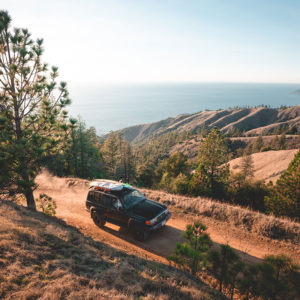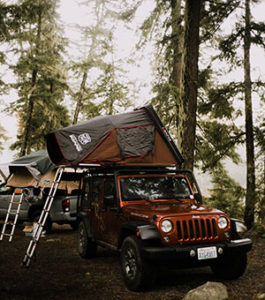EVERYTHING YOU NEED TO KNOW ABOUT OVERLANDING
Have you ever been asked or stopped and wondered “what is overlanding anyway?” Many avid travelers, especially those that prefer the company of nature and the outdoors, have heard the phrase throughout the years, but very few are familiar with the actual meaning of the term and what it entails. Overlanding, at its core, is a style of travel where the goal is to be adventurous in somewhat remote locations while being as self-reliant as humanly possible.
This method of adventure travel has been around for centuries, but it has regained its popularity in the past couple of decades with the continuous advancements in technology coming onto the market. Now that overlanding is easier and more accessible than ever, especially in the United States, there are now gatherings on both the regional and national levels, as well as expos and conventions dedicated to the subject. Whether you are a beginner or avid overlander, let us tell you all about the exciting and beautiful pursuit that is overlanding.
Here is our guide detailing everything you need to know about overlanding!
Overlanding 101: Historical Overview
Overlanding has existed in some form or another for centuries. From scientific expeditions to cross-country road trips on less-than-traveled dirt roads, the method of travel has lived on even through the time of COVID-19. This form of exploring centers heavily around the idea of self-sufficiency while seeking out remote, rarely seen or accessed locations across the globe. While it is a lot like backpacking in this way, overlanding is more frequently focused on off-road travel through the use of all-wheel or four-wheel drive vehicles. However, it is not uncommon for individuals to also traverse the terrain on mountain bikes, as well.
This variety of travel was first popularized in Australia back in the early 1900’s when the government decided to map out roadways from one side of the continent to the other as trade routes. However, overlanding became more adventure and travel-related and less commercial trade-focused in the 1940’s due to the brilliant mind of outdoorsman, pioneer, and surveyor Leonard “Len” Beadell. Because of this man, overlanding took on the recreational, outdoorsy activity it has grown into today. This self-reliant, survival-style type of travel is practiced by skilled and experienced climbers, hikers, backpackers, and thousands of others all around the world.
Vehicles for Overlanding
The easiest way to get to many of the popular, hard-to-reach locations that are famous within the overlanding community is through an off-road-ready vehicle. The type of car you drive throughout your adventures will completely depend upon where you want to go, how long you want to travel, and your general style as an adventurer. While there are countless 4WD/AWD cars and SUVs on the market today, there are a key few that you will most often see being driven by experienced overlanders: the Toyota 4Runner, Toyota Tacoma, the Jeep Wrangler, and Subaru Outback.
The key commonality between all three of these popular makes is, of course, their off-road capabilities. Without a great ability to go off the beaten path and into the desert or the woods, you can’t necessarily overland. If you would prefer safer and more predictable travels, there is always van life (we’ll get to that a little later), but the potential for self-reliance in a remote location is much easier with a car that can handle some rough terrain and the occasional unpredictable weather. We recommend outfitting your vehicle of choice with heavy-duty tires, roll cages, and whatever else you need to keep yourself upright and moving as you drive out into the great unknown.
All the Gear and Technology Available to You
Outside of a vehicle or mountain bike, there are also countless pieces of equipment and gear on the market that you may need (or just want) to allow yourself or your group to stay self-sufficient and safer for longer periods of time. As you would with backpacking, many things like tents, flashlights or lanterns, first aid kits, and food storage or absolutely essential to surviving out in the wilderness. We also recommend other items like satellite location devices, communication equipment like CB radios, and cooking stoves or utensils to make your remote, survival life easier.
However, because of the high prices and complex technology in the overlanding world, it can be tricky to know the right items to get and the unnecessary things you don’t need. While lightly used gear can be found, on various websites, many overlanders prefer new technology and the joy of purchased new gear. That’s why Overland Reviews was created – to go through and test the gear out there for you so you can have the data you need to make a properly informed decision without wasting your money on purchasing everything yourself. We review everything from communication radios to tents, vehicle gear and camping shelters. Check back often for more updates on the latest and greatest technology coming to the world of overlanding.
Where Can Overlanding Take You?

As we mentioned before, overlanding was modernized and popularized in Australia, but it has expanded far past the shores of that giant island since the early 1900’s. Here in the United States alone, overlanding has become wildly popular in states like Colorado, Oregon, and Arizona with people coming from all over the country to see some of the sites exclusive only to the remote corners of these states. However, this style of adventuring is not limited to any one country and can easily be implemented anywhere in the world.
Overlanding across state and country borders is the newest thing to do, especially in small groups or caravans. Many Americans frequently plan trips that begin in the United States and make their way all the way down to Central and South America where isolated patches of nature are somewhat easier to come by. Africa and Russia (during the warmer months) are also untapped resources for overlanding travel with their vast stretches of quiet savannah or grassland accessible only via off-roading. As long as you can get your paperwork sorted before you go, overlanding can take you anywhere!
Overlanding vs. Van Life
While overlanding has experienced its own rise in popularity, so has a similar style of travel also focused on vehicle-based self-sufficiency: Van Life. At first glance, this name may sound strikingly alike the entire premise of overlanding, but there are a few key differences that put these two adventure methods in two very different realms. As distinct as each is, both are readily available for anyone to start, allowing travelers and adventures alike choices in how they want to spend their journey!
As we know, overlanding is all about getting to the more remote and off-road locations of the world, far from civilization and any sign of other people. Van life, on the other hand, is focused much less on the type of location (many vanlifers even prefer to stay in more metropolitan locales) and more on the mobile micro-home aspect. These vans are typically built to be completely self-contained, allowing an individual, couple, or small family to live on the road 24/7/365 without the need for camping or a standard, permanent home. Overlanding, on the other hand, is a more rugged, short-lived type of travel that many only do for days, weeks, or a few months at a time.
How to Get Started on Your Overlanding Adventure
 If you are curious about overlanding for the first time or are interested in expanding into a new form of travel more mobile than backpacking, then you will have to learn a few skills and do a little bit of planning first. While trip-planning may seem like the obvious starting place, you should always have your basic survival skills down first. This can include things like CPR, understanding how to start a fire or forage for food, and even what to do when you encounter poor weather – or worse – a dangerous wildlife encounter.
If you are curious about overlanding for the first time or are interested in expanding into a new form of travel more mobile than backpacking, then you will have to learn a few skills and do a little bit of planning first. While trip-planning may seem like the obvious starting place, you should always have your basic survival skills down first. This can include things like CPR, understanding how to start a fire or forage for food, and even what to do when you encounter poor weather – or worse – a dangerous wildlife encounter.
Once you understand the essentials and feel confident with the idea of being removed from society in the outdoors, you’re ready to expand your knowledge. If you’re planning on getting out and about in a vehicle, you should know how to handle an off-roading vehicle and the potential situations that could arise when driving. You will also want to learn how to navigate without relying on your usual smart phone maps and start learning everything you can about your gear. The old saying “you can never be too prepared” could never be more applicable than on the subject of overlanding. Find all the resources you can and read them top to bottom; even if you’re not going alone, it’s always best to know too much than not enough.
And that’s all there is to it! Now that you have everything you need to know about overlanding to get started, there’s nothing holding you back from hitting the pavement and finding that perfectly quiet back road and enjoying some solitude and self-sufficiency for a short while.
Are you ready to start overlanding or want to know more about all the great locations and technology out there for you? Take a moment and read through some of our gear reviews so you can be more informed and make a better decision on how you prepare for your next (or first!) overlanding trip. If you are curious to learn more or would like to see a certain item reviewed, please don’t hesitate to contact me!
Safe travels!